Covenant is a flawed and fascinating episode.
In its own way, although obviously a much less extreme manner than The Siege of AR-558, this is an episode that could only have been produced on Star Trek: Deep Space Nine. This is not simply down to matters of continuity, and how the episode ties into the mythology of the series. More specifically, it is an exploration of religious themes and ideas that is only really possible within the framework of this particular Star Trek spin-off. It is difficult to imagine Star Trek: The Next Generation or Star Trek: Voyager tackling the idea of religious cults so effectively.

Altaring his plans.
Part of this is down to a lingering suspicion that the other Star Trek shows subtly (or not so subtly) consider all religions to be cults. After all, shows like The Return of the Archons, The Apple, For the World is Hollow and I Have Touched the Sky, Justice, Who Watches the Watchers? and Devil’s Due left little room for ambiguity. The other Star Trek series seem downright hostile to the idea of religious belief, even if episodes like The Cloud and Sacred Ground might suggest a more open-minded approach to spirituality.
Deep Space Nine has generally been more willing to engage with the idea of religious belief as something that is worthy of exploration and consideration, something that is for an individual to determine on their own terms. Some characters on Deep Space Nine are explicitly atheist, like Jadzia Dax or Odo. Some characters hold strong religious beliefs, like Kira or Nog. Some characters believe in spiritual traditions without ever seeming particularly devote, like Worf. Some characters even evolve over the course of the series, like Sisko.

Preach out and touch faith.
This willingness to accept multiple facets and forms of religious belief allows Deep Space Nine to construct a story like Covenant. In any other Star Trek series, Covenant would seem like a knee-jerk dismissal of religious faith and organised belief, the tale of how a group of Bajorans were swindled by a charismatic leader with tragic consequences. It would be read as a generic condemnation of religious belief, an endorsement of an atheistic worldview that has developed beyond the need for such superstition.
Instead, Covenant is something more interesting and nuanced than that. It is an episode about a particular kind of belief, about a particular sort of religion. It is an episode about the dangers of a very particular form of worship. It is an episode about the perils of religious cults, but one which understands the distinction between that and other forms of spirituality.

He hasn’t a prayer.
These sorts of fringe religious organisations are arguably of particular interest in the context of American popular history. This is not to suggest that they are a uniquely American phenomenon. There are plenty of organisations from all over the world (and all across history) that would reasonably be described as “cults.” Germany, for example, has a history of actively monitoring these sorts of organisations within its borders, whether their origins are domestic or international. France also keeps an eye on its religious movements.
In the late eighties, a drug smuggling cult operating out of Matamoros participated in human sacrifice, believing that the practice would protect them from both their enemies and from the authorities. In the mid-nineties, the Aum Shinrikyo cult released nerve gas on a crowded subway platform in Tokyo, after a failed attempt to attack targets like two U.S. Naval bases, the Narita airport, the Japanese Diet, the Imperial Palace, and the headquarters of a rival religious group. It could fairly be argued that ISIS is itself an apocalyptic cult.

It earrings true.
However, American popular culture has long been fascinated by the prominence of religious cults within the United States, particularly in the context of the second half of the twentieth century, an era that (likely not coincidentally) overlaps with the beginning of the so-called “American century.” For example, these cults tend to pop up in the work of auteur Paul Thomas Anderson, most notably in his Oscar-nominated classic The Master and as a subplot in his Pyncheon adaptation Inherent Vice. Chris Carter would play with the idea in both The X-Files and Millennium.
Most obviously, Scientology was a recurring fixation for American pop culture from the nineties into the new millennium. (Germany identified the organisation as a cult, and many commentators would agree, even if the American classification of the group is somewhat fungible.) Despite the group’s notoriously litigious nature, the organisation has been subjected to countless documentaries and thinly (or not-even-thinly) veiled portrayals in film and television. However, Scientology is far from the only cult to capture the public’s interest.
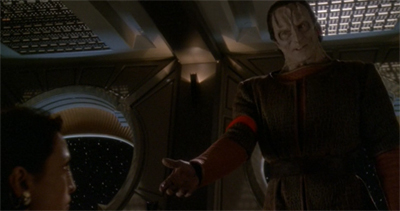
“Would you like a red band teaser?”
The history of American faith is filled with charismatic leaders, eager to change the world and to destroy it. In a nation founded by religious radicals in search of freedom, we are raised to believe and raised to protect the right to believe at all costs. The faithful pushed their wagons into the empty west, missionaries and prophets spreading the word, building utopian societies with a violent certainty. The Mormon pioneers irrigated and settled an uninhabitable land of salt lakes. Their communal, utopian church would split over the practice of polygamy, which stood in opposition to the government and statehood. The recent raids on the fundamentalist Mormon Yearning for Zion Ranch of Warren Jeffs in Texas reminds us of the history of secret societies, with young women in pioneer dresses, trapped in cycles generations old, of men who must have multiple wives to attain the highest levels of heaven, a tenet of faith revealed by the founder of the Church of Jesus Christ of Latter Day Saints, Joseph Smith.
In a post-war world, our faiths have turned darker and deadlier. We have grabbed hold of our freedom with both hands. Urbanization has led to isolation, to a rootless people in search of connection, estranged from the families that might have cautioned them or saved them. New cults formed in cities with followers drawn to a range of new gurus, Sun Myung Moon, Mahareshi Mahesh Yogi, “Fathers” Yod and David “Moses” Berg. All have been accused of a range of abuses, sexual, physical, mental, financial. Groups were made through abduction and maintained through brainwashing. New Age communes developed on the fringes, where charismatic men gathered harems and drugs provided the only escape.
Historically and culturally, cults have held a very special place in the American popular consciousness since the end of the Second World War. This is no surprise; they provide an interesting avenue to explore themes of identity and belief.

“So… anyone have some exposition they’d like to add?”
It should be noted that this interest is particularly focused on the west coast of America, particularly in California. Of course, there are countless examples of American cults outside of Los Angeles; the People’s Temple in Jonestown, the Branch Davidian compound in Waco. However, there have been a lot of iconic and well-known religious movements concentrated in California over the years: Scientology, the Manson family, the Children of God, the Source, the Symbionese Liberation Army, Heaven’s Gate.
In some ways, this might account for the outsized popularity of cults within American pop culture. Given that most of American pop culture is rooted in California, it makes sense that most writers are based in California. With that in mind, it makes sense that these concerns should be reflected in their output. This is not the only time that Star Trek has demonstrated that west coast bias; consider the fixation on gang violence in stories like The Abandoned, Caretaker, Initiations or the New Age sensibilities of Tattoo or Star Trek: Insurrection.

Dukat always was a cult figure.
Historically, ever since the railroads connected the West Coast to the East, it was always the land of opportunity and utopia. A big part of it was the weather and the escapism that weather represented. It’s a natural place where oranges grew—a sort of Eden, basically. It was like that and then with entertainment and Hollywood, that fuelled the whole escapist mentality. Everything worked together to make California and Southern California a haven for cults and movements like that.
It should also be noted that the west coast represents the literal end of the American Dream, the final frontier of Manifest Destiny.

The Mondo “Emissary (Variant)” poster design was hugely controversial.
Covenant is very much engaged with the idea of cult belief, but it explores it from the perspective of a character who has religious faith. As such, Covenant does not feel like a knee-jerk rejection of religious belief, but a more nuanced exploration of a particularly dangerous type of faith. As with Once More Unto the Breach, the teaser to Covenant is structured in such a way as to introduce its thematic ideas as early as possible through a seemingly innocuous conversation between several regular characters, including the story’s featured regular.
This is a very small structural detail, but one that demonstrates how technically proficient the writing staff on Deep Space Nine had become at structuring a story like this. It is something that Deep Space Nine just does without drawing attention to it, while Voyager often seems to struggle to set up its themes and ideas in its own disconnected teaser scenes. Covenant is hardly the best constructed episode of the seventh season of Deep Space Nine, built little details like this ensure that it seems much more confident and purposeful than the vast majority of Voyager episodes.
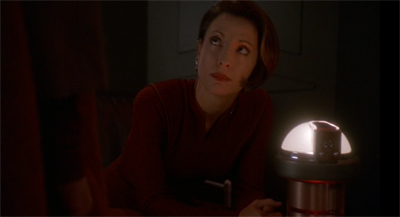
Shedding some light on Fala’s conversion.
Similarly, Covenant itself serves a very clear and important role in the overall structure of the season. The sixth season of Deep Space Nine often struggled to keep all of its key characters and elements in focus, with major characters like Damar or Weyoun or Garak disappearing from extended stretches in the middle of the season. The audience did not get a chance to spend any time with Martok between You Are Cordially Invited… and Tears of the Prophets, to give one especially egregious example.
The seventh season does a much better job of keeping all of its elements in focus and all of its characters in play. The writers are keenly aware that this is the final season of Deep Space Nine and understand that there is a need to keep track of important threads across the year. Covenant is the first appearance of Dukat since Tears of the Prophets and the first use of the Pah-Wraiths since Shadows and Symbols. There is a sense that Covenant is effectively “checking in” on these two plot elements, aware that they will be of use later on in the season.
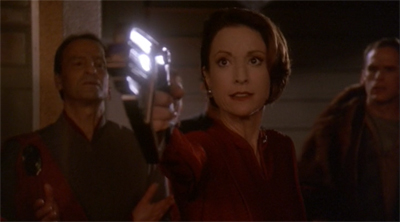
Giving Dukat’s arc a shot in the arm.
Covenant demonstrates just how deftly the Deep Space Nine writing staff have come to understand the workings of continuity. The episode references and builds upon previous episodes, using Empok Nor from Empok Nor and The Magnificent Ferengi, referencing the death of Jadzia and Dukat’s union with the Pah-Wraiths from Tears of the Prophets, and even mentioning the Pah-Wraith cult that appeared on the promenade and attacked Sisko in Image in the Sand. (The episode also invited the user to speculate whether Dukat was involved in that stabbing.)
At the same time, none of these elements intrude on the narrative of Covenant. This is very clearly a single cohesive narrative, a story that can be told and considered on its own terms, with its own thematic concerns. Covenant is more that just a chapter in an unfolding narrative. In fact, Covenant is arguably something of an outlier as far as the overall plot involving Dukat and the Pah-Wraiths works. Instead, Covenant builds on all these preexisting elements to tell a story that is both worth telling in its own right and strengthened by this surrounding context.
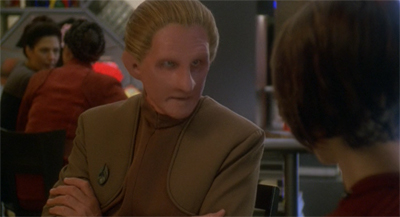
“Well, I guess it would be nice…”
In the introductory scene, Kira discusses her faith with the other regular characters. Covenant establishes Kira’s faith as a very benevolent (and even empowering) religious belief. Odo laments that he cannot share Kira’s faith, but she seems perfectly accepting of that. Kira is a believer who has enough self-belief that she does not need Odo to validate her faith. Instead, she simply hopes he might get something worthwhile from faith, if he wants. “Would it bother you if Odo believed in Klingon religion?” Ezri asks. “Not if he got something out of it,” Kira responds.
This idea is reinforced once Kira is taken to Empok Nor. Kira is obviously uneasy with the very idea of the Pah-Wraith cult, given her belief in the Prophets and the fact that she has witnessed their violence in episodes like The Reckoning and Tears of the Prophets. In conversation with Fala, Kira is quite explicit that she could never be convinced to accept the Pah-Wraiths as her gods. “We can’t both be right,” she advises Fala. However, Kira seems more unnerved with how the worshippers express their faith than with the fundamental idea of their religion.

The sheer Gul of this guy…
“I’ve always found that when people try to convince others of their beliefs it’s because they’re really just trying to convince themselves,” Kira tells Benyan, while in the middle of a tour of the station with Fala. Kira is comfortable enough with her beliefs that she never feels the need to convince others, that she can accept that other people hold different religious beliefs and that this is not an irreconcilable difference. However, the faith demonstrated by the cult on Empok Nor is different. It is more desperate, more performative, more theatrical.
“We all work very hard for what we have,” Benyan warns Kira. “We don’t need you or anyone else to approve of us.” However, his words ring hollow. Fala and Dukat have very clearly kidnapped Kira in the hope of earning her validation and respect. “Nerys, the Master brought you here because he cares about your spiritual well being,” Fala assures Kira, but his argument is unconvincing. Tellingly, the first thing that he does on meeting her on Empok Nor is to offer her a guided tour. Fala and Dukat clearly aspire to earn Kira’s respect, if not her worship.
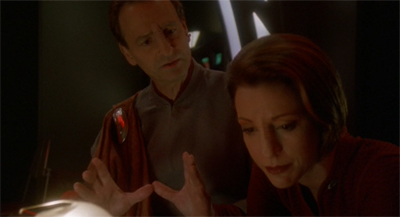
A hostile cult-ure.
The Pah-Wraith cult as featured in Covenant is clearly inspired by Heaven’s Gate. That movement emerged in the mid-seventies, led by Marshall Applewhite and Bonnie Nettles. The group tied together New Age religious beliefs with a mythology built around aliens and unidentified flying objects. The group was a fringe movement, but attracted attention and headlines for the mass suicide of thirty-nine members in April 1997. There are still some members of the organisation, who remain alive and updating the Heaven’s Gate website.
The Heaven’s Gate suicide caught many people by surprise, and left an indelible mark on popular culture. However, it had a particularly strong connection to the Star Trek franchise. Thomas Nichols, the brother of Star Trek actor Nichelle Nichols, was one of those who committed suicide. Reportedly, those committing suicide referred to themselves as “the Heaven’s Gate Away Team” making contact with an alien craft hidden behind a comet; the language was very much in keeping with the Star Trek franchise.

Praying on the weak and the vulnerable.
Part of what was so compelling about the Heaven’s Gate suicides was the fact that the cult did not appear to have engaged in the same sorts of brainwashing and intimidation employed by the People’s Temple or Scientology. As Benjamin E. Zeller outlined in Heaven’s Gate: America’s UFO Religion:
Clearly the leaders of Heaven’s Gate engaged in acts of religious persuasion. They used adherents’ emotions, preexisting convictions, hopes, and fears to attract them to join the movement and stay within it, though it must be noted that they also encouraged members who seemed to be waffling to leave. This is of course basic advertising, and one finds the same process at work in most religious movements. Heaven’s Gate represents an extreme example because the group’s leaders demanded so much from their followers and offered far more in return. According to the rational choice model of religious social dynamics, this sort of trade-off of high demands and high rewards functions to attract a niche of serious spiritual seekers, just as very costly commercial goods (expensive cars or foods) also attract niche consumers. This also helps explain why Heaven’s Gate remained so small. Members joined not because of some sort of magical psychological or spiritual trick that the leaders conjured, but because they were looking for something and believed that they found it in Heaven’s Gate.
In the context of a mass suicide, this was deeply unsettling. Why would thirty-nine people kill themselves if they were not being coerced or brainwashed or blackmailed? How could people really believe in something like this to an extent that they would take their own lives on such an obviously ridiculous premise?

The bitterest pill.
Covenant explores these themes and ideas, most notably at the climax of the episode when Dukat tries to cover for his own indiscretions by convincing his fellow cult members to commit suicide. He distributes pills, arguing that the Pah-Wraiths want their followers to ascend. “We have proven ourselves worthy of the Pah-Wraiths,” Dukat assures his followers, “and they are calling us home. This is the means of our deliverance.” It is not quite an alien ship hiding behind a comet, but it is almost.
Of course, unlike Marshall Applewhite, Dukat has no plans of committing suicide with his followers. There are certainly historical precedents; Ilya Sidorov was arrested for presiding over a suicide and self-harm cult, while cult leader Adolfo de Jesus Constanzo was suspected of faking his own death to avoid the authorities. This is very much in keeping with what Deep Space Nine has already established about Dukat as a character. Covenant allows for a short scene of Dukat praying to establish that his faith is genuine, but even that faith cannot overcome Dukat’s naked self-interest.
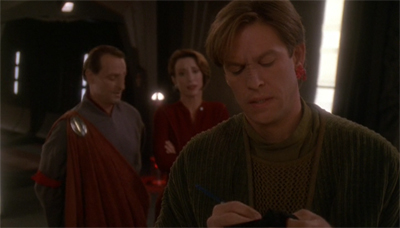
The art of self-deception.
However, even after Kira exposes Dukat as a charlatan, and even after most of the community turns against him, Fala still commits suicide. His action is left somewhat ambiguous and open-ended, as suicide often is. When Kira demands to know why Fala would commit suicide, even knowing that Dukat was a fraud, he simply responds, “Faith.” Kira confesses to Odo, “I keep going over what he said when he died and I don’t know if he was trying to tell me if he never lost his faith or that he felt betrayed by it.”
Covenant leaves enough wriggle-room either way, but it also suggests a third possibility. Was Fala so desperate to believe that he would commit suicide in order to validate that belief? Was his suicide simply an affirmation (to himself as much as to Kira) that he still had faith? Covenant suggests that these sorts of cults thrive on the performance of faith, whether through the gigantic painting that Benyan is working on, the one-on-one prayer sessions with Dukat, the entire attempt by Dukat and Fala to convince Kira of the validity of their faith.

Remember our Fala-n comrades.
Indeed, it is tempting to read Dukat’s private prayer to the Pah-Wraiths as that sort of performance of faith, a clear attempt to convince himself of the validity of his faith. “I failed you,” he admits, which is no small admission for a man of Dukat’s ego. “Forgive my weakness. Forgive me for letting temptation obscure the path you’ve laid out for me.” He begs, “Tell me what to do. Please. Please.” Naturally, what Dukat decides that the Pah-Wraiths have asked him to do saves both his reputation and his life. Convenient, that.
This is consistent with Dukat’s character. Ego and insecurity have always been Dukat’s primary weaknesses. Dukat is very good at presenting himself as something resembling a decent person, even if his behaviour repeatedly falls short. After all, his decision to spare Ziyal’s life in Indiscretion is very much intended as a gesture to earn Kira’s respect. Dukat is convinced that he loves Ziyal, to the point that he was driven mad by her death (in combination with his loss of the station) in Sacrifice of Angels, but he is perfectly willing to sacrifice her as a pawn in By Inferno’s Light.
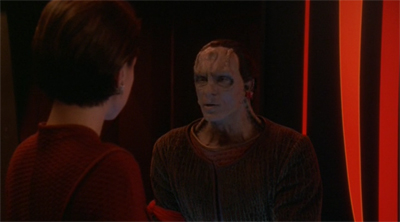
He will pay a steep Kosst for this.
Indeed, the decision to cast Dukat as a cult leader makes a certain amount of sense, and not just building off his alliance with Kosst Amojan in Tears of the Prophets. Dukat has always had a unique view of the way in which the universe works, has always believed that he deserved the appreciation of those under his boot, and always imagined himself as an equal to Benjamin Sisko. All of these elements combine in such a way as to make “Pah-Wraith Cult Leader” a much more logical character development than “Pulp Space Pirate” was in Return to Grace.
It should be noted that while the cult that Dukat founds is explicitly religious, a cult of personality tends to develop around high-profile political leaders with authoritarian leanings. Josef Stalin is a great example of a dictator who cultivated a cult of personality around himself. Alfredo Stroessner feigned a humble attitude, but structured Paraguayan society so as to advance his followers. Even deposed dictators like Saddam Hussein maintained a cult of personality after their government had been toppled and they had been reduced to flotsam of history.

Political suicide.
These cults are not unique to foreign dictatorships, and can develop even in the most unlikely of places. Cult survivor Teddy Hose has likened Donald Trump to the leaders of religious cults like Sun Myung Moon:
Rev. Moon had charisma; a certain charm and humor that won over followers who thought, “He’s rich and powerful, yet so down to earth.” Those seeking security, respect, friendship, and/or identity were suddenly welcomed into his spirited community. It was a virtue to trust his wisdom over trusting oneself. What unacknowledged member of society would not lose themselves in this revolutionary who spoke to their values? Surely, he could Make America Great Again.
To church members attending Moon’s hours-long lectures, his grandiose message progressively overshadowed his faults. Members coasting on this momentum found more immediate gratification over stopping to question. For example, Moon defended his marital affairs as providential. I remember being told not to process this interpretation with our fallen minds, but with our (Moon-indoctrinated) original minds. Likewise, Trump supporters seem to focus more on how he makes them feel, over the integrity of his leadership.
Much like cultist follow their leaders through disgrace and humilation, Trump’s supporters will still back him even as they lose their health care and vital services. This is not the first time that Dukat has been likened to Donald Trump.

Faithless elector.
As such, there is something very powerful in the image of the disgraced and fallen Dukat who has manoeuvred himself to the head of a Pah-Wraith cult, who has managed to convince an entire station full of Bajorans to worship him. It is a character beat that feels organic the context of what came before, but very clever in its own right. Indeed, Covenant is easily the best Dukat-centric episode to be produced after Waltz, if only because it fundamentally understands his character on a level beyond “Dukat is the antagonist of the show.”
Indeed, Covenant is absolutely fascinated by the character of Dukat beyond his plot function as the primary antagonist of the series. It is worth noting that Covenant is the last episode of Deep Space Nine to focus on the relationship between Kira and Dukat. The final epic serialised story arc has a fascinating thematic reversal that places Kira undercover on Cardassia and Dukat undercover on Bajor as it builds to a climax, but it tends to focus on Dukat as a nemesis for Sisko. Instead, Covenant devotes its entire opening act to a conversation between Kira and Dukat.

Heated discussions.
Covenant even makes a belated (and clumsy) attempt to add some nuance and shading to Dukat’s character arc in the wake of Waltz. The union of Dukat and the Pah-Wraiths in Tears of the Prophets amounted to little more than the effective union of two of the show’s major antagonistic forces, consciously designed as an outrageously evil counterpoint to the relationship between Sisko and the Prophets. Waltz had made it very clear that Dukat was “truly evil”, but Tears of the Prophets seemed to suggest that Dukat was nothing but truly evil.
Covenant at least attempts to rectify this by trying to offer a plausible explanation for why a bunch of Bajorans would move to an abandoned station on the edge of Dominion space to worship the demons that had cut Bajor off from the wormhole in Tears of the Prophets under a Cardassian who had overseen the systematic slaughter of millions of Bajorans during the Cardassian Occupation. More than any other episode, Covenant touches on the question of why anybody other than the seemingly-one-hundred-percent-evil Dukat would choose to follow the Pah-Wraiths.
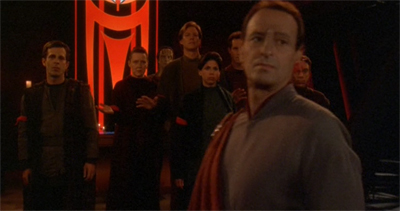
Shielding Dukat’s reputation.
One of the most underrated writers in the larger history of the Star Trek franchise, René Echevarria is a writer who has a tendency to engage with these sorts of interesting questions of motivation and perspective. To pick a relatively recent example, Chrysalis is one of the stronger Star Trek romances in part because it acknowledges how problematic Star Trek romances can be, with its characters even discussing some of the clumsier storytelling conventions employed in these sorts of stories. So it makes sense for Echevarria to engage with the challenge posed by the Pah-Wraiths.
Logically, and building upon the pop Christian iconography that has been attached to the Pah-Wraiths in episodes like The Assignment and The Reckoning, Echevarria casts the Pah-Wraiths as something akin to a Miltonian Lucifer cast out of the Celestial Temple for daring to challenge the uncaring Prophets. “The Pah-Wraiths are not what you think, Nerys, and neither am I,” Dukat challenges Kira. “Have you ever wondered why the Prophets stood by and did nothing when Cardassia took over Bajor? Have you ever asked yourself how they could allow your people to suffer as they did?”

Dukat’s rapidly closing window of opportunity.
It could be argued that Dukat’s Miltonian reinvention of the Pah-Wraiths fits within the particularly American framework of these sorts of fringe religious cults. Edward Simon has argued that the reconceptualisation of Lucifer by Milton in Paradise Lost resonates with an American world view:
Many of the values the archangel advocates in Paradise Lost—the self-reliance, the rugged individualism, and even manifest destiny—are regarded as quintessentially American in the cultural imagination. Milton may be a poet of individual liberty and conscience, but he was also one of the most brilliant theological explorers of the darker subjects of sin, depravity, and the inclination toward evil. Nothing demonstrates that inclination more than the long-standing appeal the charismatic Lucifer has had for audiences, an appeal mirrored by the flawed but alluring protagonists of some of TV’s greatest American dramas. What Milton’s Paradise Lost, the first version of which was published in 1667, also demonstrates is what can be so dangerous about mistaking an antihero for a hero.
In some ways, Dukat’s appropriation of the Bajoran religion is distinctly American in character. Dukat rejects the idea of the Prophets as Eastern-influenced spiritual forces at work in ambiguous and indirect ways, instead advocating for the Pah-Wraiths as more conventionally Christian dynamic and hands-on gods.

Good gods, y’all.
Dukat cuts through Kira’s half-hearted defense of the Prophets. “Even as you speak those words, you must know how hollow they sound. No, there’s a much better explanation. One that makes perfect sense. The Prophets are not the true gods of Bajor, the Pah-Wraiths are. They were cast from the Celestial Temple because they wanted to take an active role in Bajoran life. Their only crime was that they cared about your people. But they were not allowed to help you because they’d lost the battle for heaven and were forced to flee.”
It is certainly an interesting twist on the Pah-Wraith mythology as suggested by earlier episodes, building off the rich themes of Paradise Lost to suggest a greater moral ambiguity than stories like Image in the Sand or Shadows and Symbols. Explaining how the Bajoran religion has come to hate and fear the Pah-Wraiths, Dukat offers a very simple explanation. “History is written by the victors,” he advises Kira. It is a reasonably compelling argument, if taken in isolation in the context of Covenant.

“My conman sense is tingling.”
The biggest issue with all of this is that Covenant cannot possibly be taken in isolation. The script’s efforts to add some ambiguity and nuance are laudable, but also far too late. The Pah-Wraiths have been consistently portrayed as monstrous villains in episodes like The Assignment, The Reckoning and Tears of the Prophets. Even Kira understands that Deep Space Nine has committed too readily to the idea of the Pah-Wraith as monstrous villains to ever develop them into nuanced or ambiguous figures.
“It was only inside of me for a very short time,” Dukat remarks of the Pah-Wraith from Tears of the Prophets, “but it opened my heart.” Kira very coldly, but entirely fairly, responds, “Would that be before or after you killed Jadzia?” It is a very simple question that immediately punctures all the self-righteous rhetoric employed by Dukat. The best that Dukat can do is to hastily fumble an answer, “That was most unfortunate, but it couldn’t be helped. The Celestial Temple itself was at stake and she was in the way.”

“We need to band together.”
Of course, Covenant is not really attempting to introduce moral ambiguity concerning the Pah-Wraiths. After all, the Pah-Wraiths go back to be being omnicidal maniacs in the run of episodes leading to What You Leave Behind. All that Covenant is trying to do is to provide enough ambiguity in the context of this individual episode to explain why some Bajorans might choose to worship the Pah-Wraiths. Those Bajorans who have not directly experienced the events of The Assignment, The Reckoning and Tears of the Prophets. It’s a more abstract question.
It is a very clever piece of writing from Echevarria, one that suggests a possible fix to one of the bigger issues with the final seasons of Deep Space Nine. Similarly, Covenant also does some very good work with the character of Gul Dukat, particularly dealing with his long-standing attraction to Bajoran women, itself a very literal expression of Dukat’s need to be loved by the very people that he is oppressing. Covenant introduces Dukat’s second half-Bajoran child, at least as far as the audience is concerned, as he abuses his powers as spiritual leader to indulge his vices.
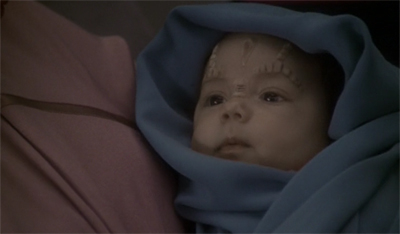
Yeah, Dukat should probably invest in some protection at this point.
Covenant also plays as something approaching a criticism of the clumsy sexual politics of Wrongs Darker Than Death or Night, a late sixth season episode that seemed to suggest that Kira’s mother was in some way a collaborator because she was taken to Terok Nor as a “comfort woman” during the Cardassian Occupation. Kira Nerys openly resented and condemned her mother for living a life of luxury as Dukat’s mistress, glossing over the fact that Kira Maru never really had a choice due to the existing power dynamics.
In Covenant, Kira rather explicitly calls Dukat out in a way that would suggest she has absolved her mother of those charges of collaboration. “You want a thank you?” she demands of Dukat. “You were working people to death in the ore processing centre, but that didn’t stop you from strutting around Terok Nor, picking out Bajoran women to take to your bed and actually believing that they wanted to be there.” It is a very pointed observation, one that quite astutely suggests that consent is impossible within such an imbalanced dynamic.

The argument is dematerial.
(This idea is also hinted at in Chrysalis, albeit in a much more benign sort of way. Echevarria’s previous script suggested that it was impossible for Serena to ever truly love Bashir, because of the preexisting dynamic between them. Serena owed her life to Bashir, and lacked any real understanding of complex interpersonal relationships, so she could only offer (and, worse than that, felt compelled to offer) an approximation of love. Of course, Bashir was more mindful of this than Dukat, and his transgression was a lot less severe. However, it is an interesting parallel.)
“Your mother did want to be there,” Dukat responds. Much like his gestures of faith, it is ambiguous as to who Dukat is trying to convince. Kira presses the charge. “You took her away from her children,” she elaborates. “She did what she had to so that we could survive.” Dukat counters, “She loved me.” Kira allows for a very nuanced and even-handed response. “Maybe she convinced herself that she did, which is a very different thing,” she states. Much like Dukat’s elaboration on the motivations of the Pah-Wraiths, this is nice piece of retroactive characterisation and development.
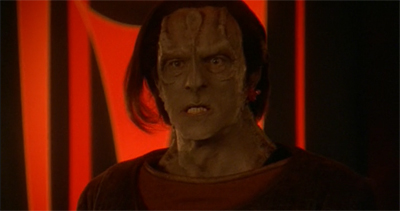
“May we should call him Gel Dukat, eh?”
In some ways, the subplot with Mika serves to revisit the plot of Wrongs Darker Than Death or Night in a way more sympathetic to Kira Maru. Obviously, Dukat’s abuse of trust with Mika mirrors any number of real-life cult leaders who abused the power that they held over their followers; Wayne Bent, Tony Alamo, Warren Jeff, Jung Myung Seok, William Kamm, Theodore Rinaldo, Dwight York, Jim Jones, and many others. It is a plot beat that very clearly exists within the framework of a story about a cult. (It is a feature of other cult narratives like Martha, Marcy, May, Marlene.)
However, this behaviour also exists in the context of Dukat’s other established relationships with Bajoran women during the Bajoran Occupation; specifically, Tora Naprem and Kira Maru. Whereas Wrongs Darker Than Death or Night seemed to hold Maru accountable as a pseudo-collaborator, and while Indiscretion suggested that Dukat might have honestly cared for Naprem, Covenant is entirely unambiguous on the nature of Dukat’s relationship with Mika. Mika is in no way to blame for what happened, and Dukat’s primary motivation is his own immediate desires.

Bringing up baby.
To a certain extent, a lot of the interesting work that Covenant does with Dukat and the Pah-Wraiths in lost in the shuffle later in the season. The closing scene of Covenant reinforces this idea, playing as something of a rethread of the final scene in Waltz. There, Sisko and Dax ruminate on the dangers posed by Dukat; here, Kira and Odo have a similar conversation. “He believes,” Kira tells Odo. “And that makes him more dangerous than ever.” To a certain degree, Kira is correct.
When Dukat and the Pah-Wraiths reappear in Penumbra, they are both back in the unambiguously evil roles of “major series antagonists” with a plot to destroy Bajor that ultimately leads to the series protagonist finding himself banished from the mortal plane. In many ways, the story thread focusing on Dukat and the Pah-Wraiths would be the least satisfying aspect of the sprawling ten-part series finale. It feels like the squandering of a once-great character, and the waste of a once-interesting premise.
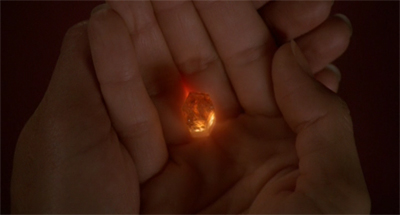
A beacon of light.
Still, Covenant offers a temporary reprieve from all this. It is undoubtedly the best Dukat-centric episode to follow Waltz, and the best Pah-Wraith-centric episode in the entire run of Deep Space Nine. It would be churlish to blame Covenant for the fact that its more interesting ideas are abandoned in the shuffle of the late-season rush. Covenant is a compelling piece of television, an engaging study of a particular type of faith and a fascinating character study.
Filed under: Deep Space Nine | Tagged: belief, covenant, cults, deep space nine, faith, gul dukat, milton, religion, star trek, star trek: deep space nine, Television, the pah-wraiths |




















I’ve heard it suggested that Dukat should never have appeared again after “Waltz” because he was subsequently reduced to a one-dimensional scenery-chewing baddie. While there is some truth to this, it ignores the fact that Dukat is very well handled in “Covenant.” In my comments about “Waltz” I believe I described Dukat as “dangerously charismatic.” Well, this episode takes that to eleven, so to speak. In “Covenant” he is genuinely terrifying in his ability to manipulate other people.
Darren, something that occurred to me while reading your write-up… In the Star Trek universe, it actually feels like religious belief would be *more* widespread, not less. Look at how much belief there is in a higher power on Earth in the 21st Century, based purely on faith, with zero impirical evidence. Now just imagine going out into the universe and bumping into all manner of mysterious cosmic-powered entities displaying amazing reality-altering abilities. Yes, obviously the rationalists in Starfleet are going to argue that Trelaine and Apollo and Q and the Prophets and all the other godlike beings are simply Sufficiently Advanced Aliens. But there are inevitably going to be people of a more spiritual or religious bent, probably quite a few, who will then argue back “You’re just trying to rationalize away what you can’t explain or understand,” who believe that these being truly are gods.
So, really, it makes perfect sense that the Pah Wraiths, who have manifested themselves and demonstrated their awesome powers to the Bajorans, actually acquire followers.
I do like the ambiguity of this episode, in that we never do find out if the Pah Wraiths are actually telling Dukat what to do, or if he’s simply done an incredibly thorough job of convincing himself that he’s doing their will. I personally think it’s the later. The fact that the Pah Wraiths *do* exist makes it all the easier for Dukat to engage in a massive case of self-deception.
It’s also interesting that Dukat, with his intelligence and magnetic personality, could potentially be a good leader who could possible achieve great things for his followers. But, once again, his ego, his craving for adoration and control, does him in.
Yeah, I think you raise a valid point that Star Trek never quite addresses. Q is functionally a god, even if there is a pseudo-scientific explanation. Even if human beings would never worship him, surely it vindicates the believe in something EVEN MORE all-powerful and EVEN MORE unseen. DS9 grapples with this idea better than the other shows, because it understands that belief is inherently different from knowledge, it is not merely an object of a similar class.
I love Dukat’s portrait. It reminds one of Street Fighter’s “M. Bison Crossing the Alps”, or Tony Soprano as Bonaparte.
Still, this episode doesn’t work, which is mostly the fault of the Bajorans. They have never been especially rich or sympathetic characters.
Things become far too simple and clichéd when we see Bajorans acting as human shields for Dukat! Are they really are as daft as their appear? It’s not a shift in their favor.
if only the writers had waited until Anjohl Tennan (“Angel”, get it?) had arrived on the planet and insinuated himself with the Kai.
I don’t know. I didn’t mind the human shields so much. If you really believe that the gods can redeem a man like Dukat, then you also believe that they expect you to protect him.
“He believes,” Kira tells Odo. “And that makes him more dangerous than ever.” This line always confused me. Dukat has always believed whether it be himself or in his latest actions. That is what has made him so disturbing.
Despite that rather odd last line, I really like this episode. I think it really captures the blind devotion that people can have and the utter consternation that those on the outside feel towards those people. Having lived in the South for 19 years, and witnessing the continual worship of the Confederacy, this episode really resonated with me.
Yeah, its depiction of faith feels very on-the-money. Which is something that DS9 did consistently better than the other Star Trek shows.
Initially I did not like this episode at all. But I come to appreciate it more and more with every watching. Close to the end one really wonders if Dukat does believe in the Pah-wraiths as being more than a means to an end in his struggle for power, only to be “disappointed” a few minutes later in the great pathetic scene where he is panicking about having lost his placebo drug. Still, it remains somewhat ambiguous. I found the central dilemma about Mika’s sort-of “immaculate conception” a clever twist.
One scene I find hard to believe though is that Mika survives her “suicide attempt”. I think this is physiologically impossible. And I wonder if it would not have been interesting if Fala took a pill in the end, but accidentally grabbed the one Dukat had lost and survived for that reason.
I have also warmed to Covenant in the years since it was broadcast. I think my initial ambivalence to Dukat’s direction as emissary of the Pah-Wraiths coloured my early response to it. But I have warmed to it in recent years.
What I like about it is that it bridges the original Roddenberry aversion regarding religion with DS9’s embracing of it by showing how wrong it can go in the hands of the wrong people. The duplicity and hypocrisy shown here is kind of stereotypical almost, but it still hurts to see it – especially if you have eperienced or see this kind of abuse of religious power in the real world.
Is there any connection between the cult’s symbol and the Judas Priest Album “Sin After Sin”? https://en.wikipedia.org/wiki/Sin_After_Sin
Oh, now this is interesting.